Significance of Democratic Leadership in Change Management
VerifiedAdded on 2020/11/12
|15
|4347
|236
Essay
AI Summary
This essay critically reflects on the significance of democratic leadership in change management, focusing on its role in reducing employee resistance. The introduction establishes the importance of change management within organizations and the pivotal role of leaders in implementing these changes. The main body delves into the characteristics of democratic leadership, emphasizing employee involvement, shared responsibility, and open communication. It explores how democratic leaders foster a sense of ownership among employees, encouraging their participation in decision-making processes and reducing resistance to new procedures. The essay examines the positive influence of democratic leadership on employee morale, motivation, and commitment, highlighting its ability to create a supportive environment. The analysis also acknowledges potential limitations, such as the time-consuming nature of democratic processes. The conclusion summarizes the key findings, reinforcing the importance of democratic leadership in successful change management and its impact on minimizing employee resistance. The essay provides a comprehensive overview of democratic leadership's significance in navigating organizational changes effectively, supported by relevant academic sources.

Critical reflection
Paraphrase This Document
Need a fresh take? Get an instant paraphrase of this document with our AI Paraphraser
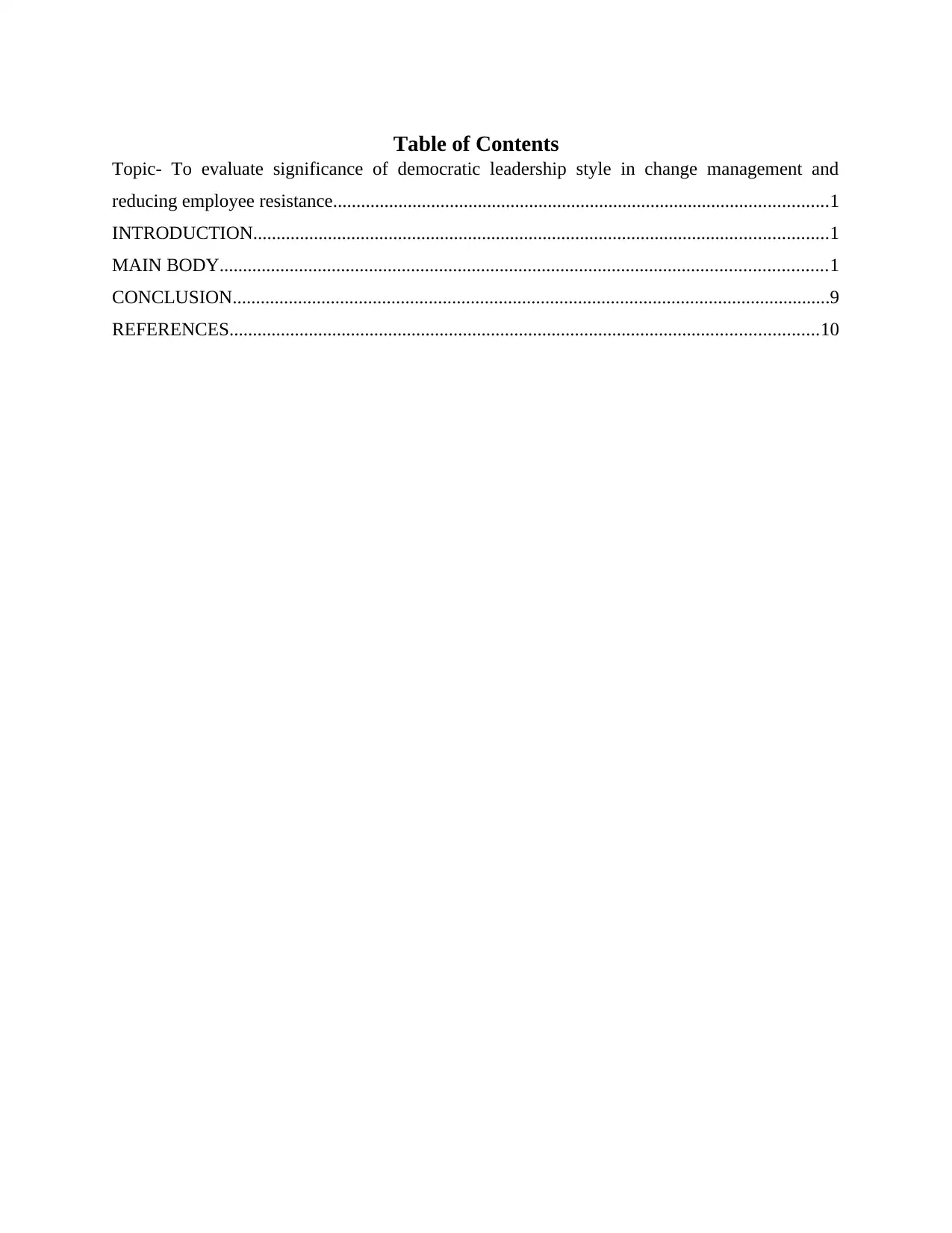
Table of Contents
Topic- To evaluate significance of democratic leadership style in change management and
reducing employee resistance..........................................................................................................1
INTRODUCTION...........................................................................................................................1
MAIN BODY..................................................................................................................................1
CONCLUSION................................................................................................................................9
REFERENCES..............................................................................................................................10
Topic- To evaluate significance of democratic leadership style in change management and
reducing employee resistance..........................................................................................................1
INTRODUCTION...........................................................................................................................1
MAIN BODY..................................................................................................................................1
CONCLUSION................................................................................................................................9
REFERENCES..............................................................................................................................10
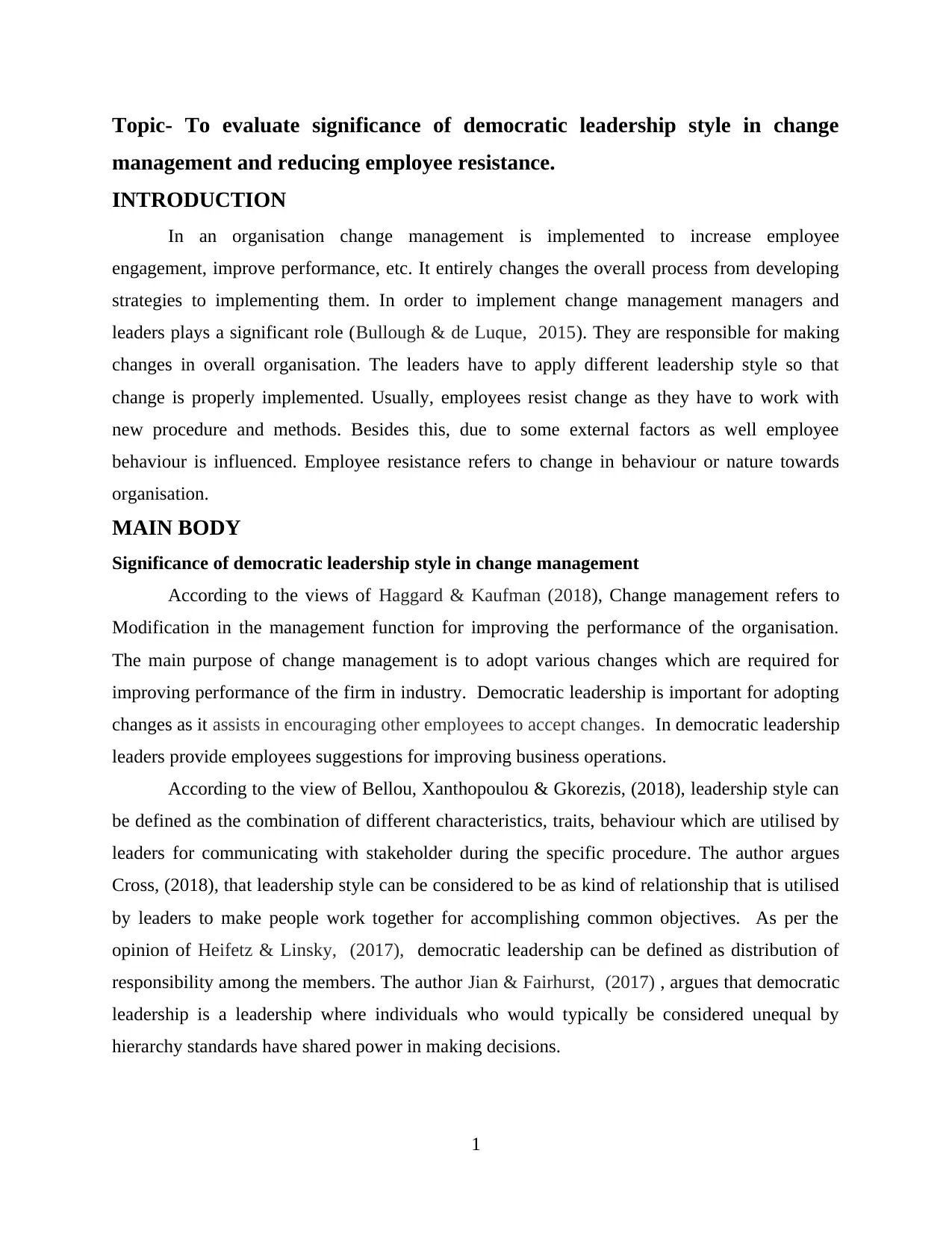
Topic- To evaluate significance of democratic leadership style in change
management and reducing employee resistance.
INTRODUCTION
In an organisation change management is implemented to increase employee
engagement, improve performance, etc. It entirely changes the overall process from developing
strategies to implementing them. In order to implement change management managers and
leaders plays a significant role (Bullough & de Luque, 2015). They are responsible for making
changes in overall organisation. The leaders have to apply different leadership style so that
change is properly implemented. Usually, employees resist change as they have to work with
new procedure and methods. Besides this, due to some external factors as well employee
behaviour is influenced. Employee resistance refers to change in behaviour or nature towards
organisation.
MAIN BODY
Significance of democratic leadership style in change management
According to the views of Haggard & Kaufman (2018), Change management refers to
Modification in the management function for improving the performance of the organisation.
The main purpose of change management is to adopt various changes which are required for
improving performance of the firm in industry. Democratic leadership is important for adopting
changes as it assists in encouraging other employees to accept changes. In democratic leadership
leaders provide employees suggestions for improving business operations.
According to the view of Bellou, Xanthopoulou & Gkorezis, (2018), leadership style can
be defined as the combination of different characteristics, traits, behaviour which are utilised by
leaders for communicating with stakeholder during the specific procedure. The author argues
Cross, (2018), that leadership style can be considered to be as kind of relationship that is utilised
by leaders to make people work together for accomplishing common objectives. As per the
opinion of Heifetz & Linsky, (2017), democratic leadership can be defined as distribution of
responsibility among the members. The author Jian & Fairhurst, (2017) , argues that democratic
leadership is a leadership where individuals who would typically be considered unequal by
hierarchy standards have shared power in making decisions.
1
management and reducing employee resistance.
INTRODUCTION
In an organisation change management is implemented to increase employee
engagement, improve performance, etc. It entirely changes the overall process from developing
strategies to implementing them. In order to implement change management managers and
leaders plays a significant role (Bullough & de Luque, 2015). They are responsible for making
changes in overall organisation. The leaders have to apply different leadership style so that
change is properly implemented. Usually, employees resist change as they have to work with
new procedure and methods. Besides this, due to some external factors as well employee
behaviour is influenced. Employee resistance refers to change in behaviour or nature towards
organisation.
MAIN BODY
Significance of democratic leadership style in change management
According to the views of Haggard & Kaufman (2018), Change management refers to
Modification in the management function for improving the performance of the organisation.
The main purpose of change management is to adopt various changes which are required for
improving performance of the firm in industry. Democratic leadership is important for adopting
changes as it assists in encouraging other employees to accept changes. In democratic leadership
leaders provide employees suggestions for improving business operations.
According to the view of Bellou, Xanthopoulou & Gkorezis, (2018), leadership style can
be defined as the combination of different characteristics, traits, behaviour which are utilised by
leaders for communicating with stakeholder during the specific procedure. The author argues
Cross, (2018), that leadership style can be considered to be as kind of relationship that is utilised
by leaders to make people work together for accomplishing common objectives. As per the
opinion of Heifetz & Linsky, (2017), democratic leadership can be defined as distribution of
responsibility among the members. The author Jian & Fairhurst, (2017) , argues that democratic
leadership is a leadership where individuals who would typically be considered unequal by
hierarchy standards have shared power in making decisions.
1
⊘ This is a preview!⊘
Do you want full access?
Subscribe today to unlock all pages.

Trusted by 1+ million students worldwide
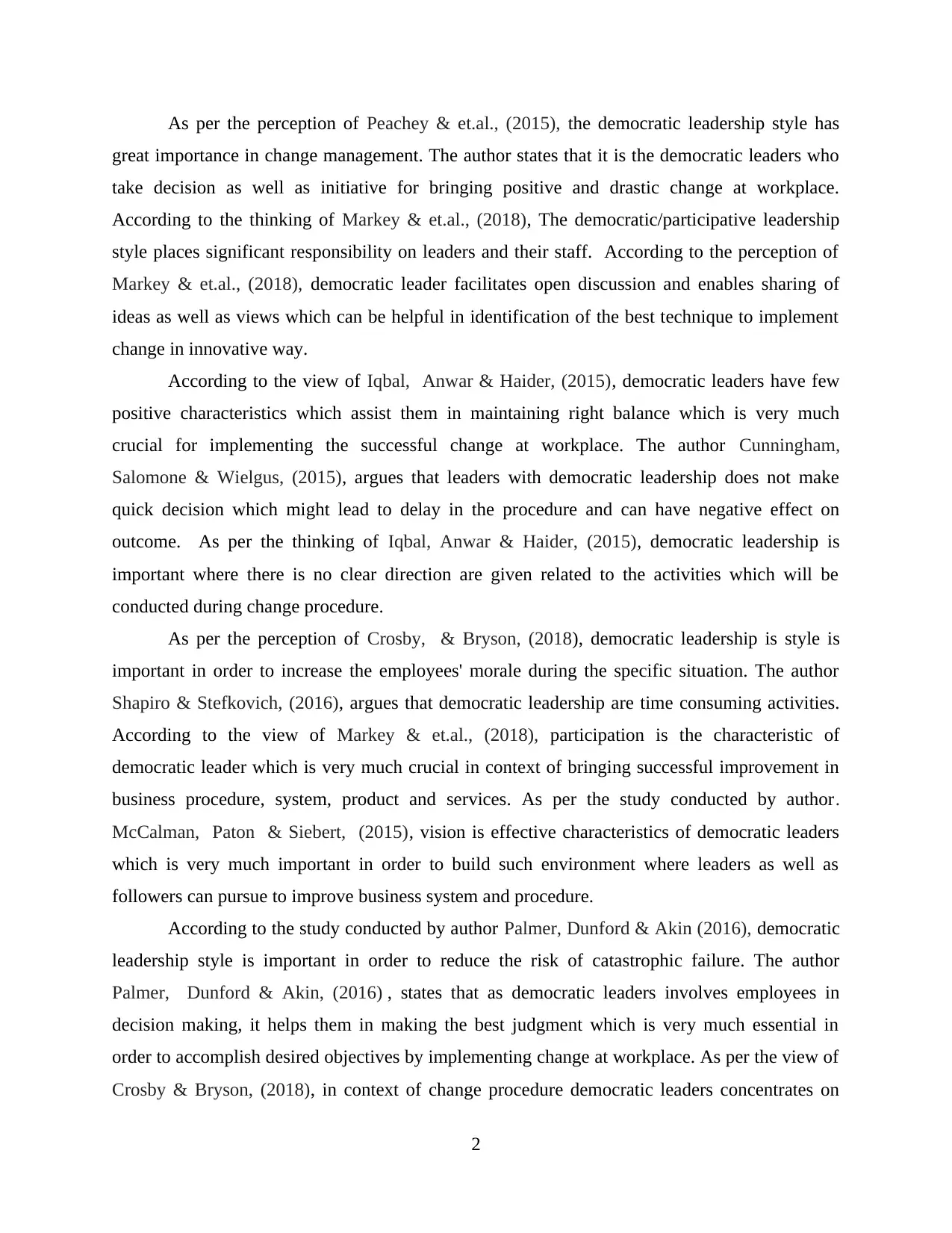
As per the perception of Peachey & et.al., (2015), the democratic leadership style has
great importance in change management. The author states that it is the democratic leaders who
take decision as well as initiative for bringing positive and drastic change at workplace.
According to the thinking of Markey & et.al., (2018), The democratic/participative leadership
style places significant responsibility on leaders and their staff. According to the perception of
Markey & et.al., (2018), democratic leader facilitates open discussion and enables sharing of
ideas as well as views which can be helpful in identification of the best technique to implement
change in innovative way.
According to the view of Iqbal, Anwar & Haider, (2015), democratic leaders have few
positive characteristics which assist them in maintaining right balance which is very much
crucial for implementing the successful change at workplace. The author Cunningham,
Salomone & Wielgus, (2015), argues that leaders with democratic leadership does not make
quick decision which might lead to delay in the procedure and can have negative effect on
outcome. As per the thinking of Iqbal, Anwar & Haider, (2015), democratic leadership is
important where there is no clear direction are given related to the activities which will be
conducted during change procedure.
As per the perception of Crosby, & Bryson, (2018), democratic leadership is style is
important in order to increase the employees' morale during the specific situation. The author
Shapiro & Stefkovich, (2016), argues that democratic leadership are time consuming activities.
According to the view of Markey & et.al., (2018), participation is the characteristic of
democratic leader which is very much crucial in context of bringing successful improvement in
business procedure, system, product and services. As per the study conducted by author.
McCalman, Paton & Siebert, (2015), vision is effective characteristics of democratic leaders
which is very much important in order to build such environment where leaders as well as
followers can pursue to improve business system and procedure.
According to the study conducted by author Palmer, Dunford & Akin (2016), democratic
leadership style is important in order to reduce the risk of catastrophic failure. The author
Palmer, Dunford & Akin, (2016) , states that as democratic leaders involves employees in
decision making, it helps them in making the best judgment which is very much essential in
order to accomplish desired objectives by implementing change at workplace. As per the view of
Crosby & Bryson, (2018), in context of change procedure democratic leaders concentrates on
2
great importance in change management. The author states that it is the democratic leaders who
take decision as well as initiative for bringing positive and drastic change at workplace.
According to the thinking of Markey & et.al., (2018), The democratic/participative leadership
style places significant responsibility on leaders and their staff. According to the perception of
Markey & et.al., (2018), democratic leader facilitates open discussion and enables sharing of
ideas as well as views which can be helpful in identification of the best technique to implement
change in innovative way.
According to the view of Iqbal, Anwar & Haider, (2015), democratic leaders have few
positive characteristics which assist them in maintaining right balance which is very much
crucial for implementing the successful change at workplace. The author Cunningham,
Salomone & Wielgus, (2015), argues that leaders with democratic leadership does not make
quick decision which might lead to delay in the procedure and can have negative effect on
outcome. As per the thinking of Iqbal, Anwar & Haider, (2015), democratic leadership is
important where there is no clear direction are given related to the activities which will be
conducted during change procedure.
As per the perception of Crosby, & Bryson, (2018), democratic leadership is style is
important in order to increase the employees' morale during the specific situation. The author
Shapiro & Stefkovich, (2016), argues that democratic leadership are time consuming activities.
According to the view of Markey & et.al., (2018), participation is the characteristic of
democratic leader which is very much crucial in context of bringing successful improvement in
business procedure, system, product and services. As per the study conducted by author.
McCalman, Paton & Siebert, (2015), vision is effective characteristics of democratic leaders
which is very much important in order to build such environment where leaders as well as
followers can pursue to improve business system and procedure.
According to the study conducted by author Palmer, Dunford & Akin (2016), democratic
leadership style is important in order to reduce the risk of catastrophic failure. The author
Palmer, Dunford & Akin, (2016) , states that as democratic leaders involves employees in
decision making, it helps them in making the best judgment which is very much essential in
order to accomplish desired objectives by implementing change at workplace. As per the view of
Crosby & Bryson, (2018), in context of change procedure democratic leaders concentrates on
2
Paraphrase This Document
Need a fresh take? Get an instant paraphrase of this document with our AI Paraphraser
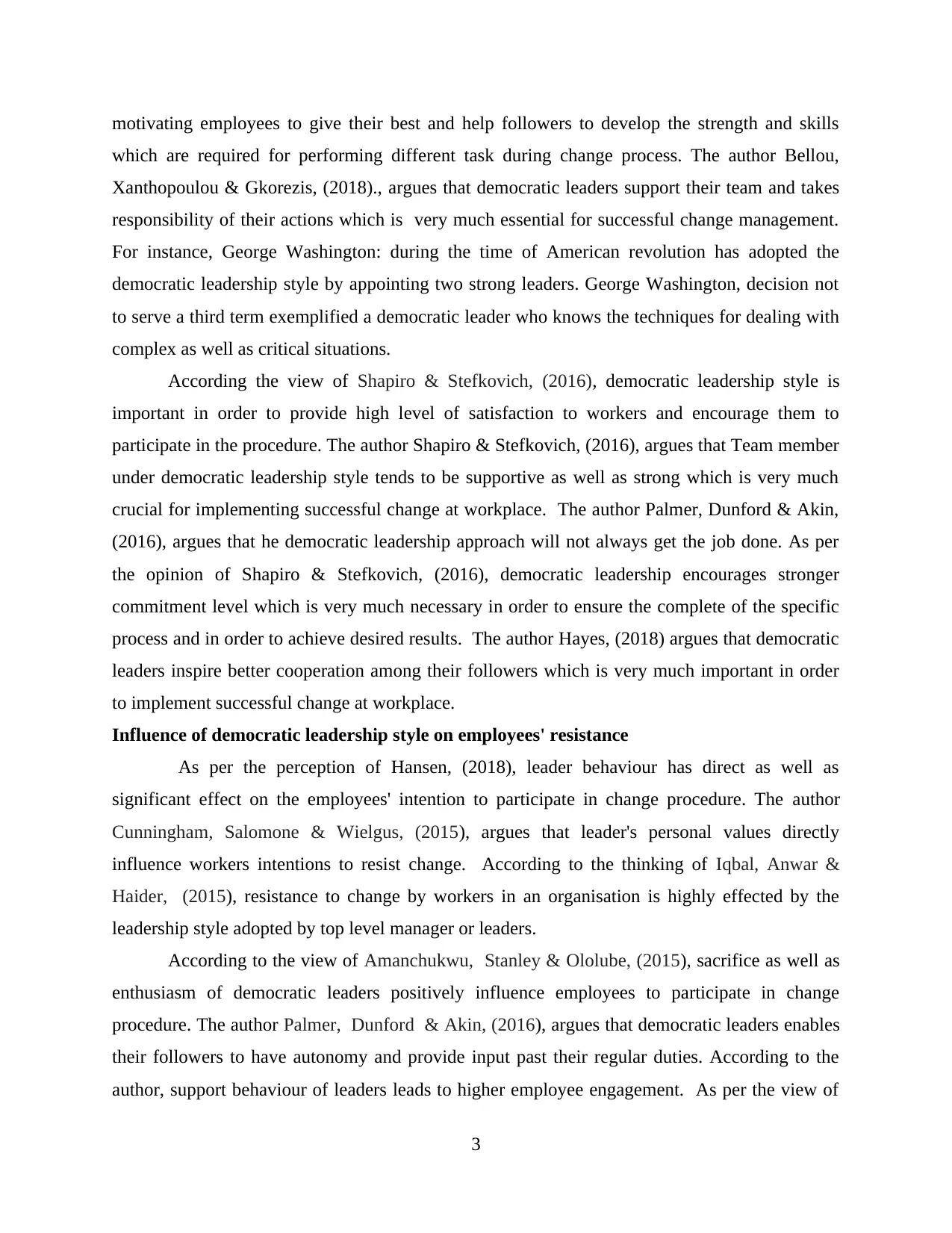
motivating employees to give their best and help followers to develop the strength and skills
which are required for performing different task during change process. The author Bellou,
Xanthopoulou & Gkorezis, (2018)., argues that democratic leaders support their team and takes
responsibility of their actions which is very much essential for successful change management.
For instance, George Washington: during the time of American revolution has adopted the
democratic leadership style by appointing two strong leaders. George Washington, decision not
to serve a third term exemplified a democratic leader who knows the techniques for dealing with
complex as well as critical situations.
According the view of Shapiro & Stefkovich, (2016), democratic leadership style is
important in order to provide high level of satisfaction to workers and encourage them to
participate in the procedure. The author Shapiro & Stefkovich, (2016), argues that Team member
under democratic leadership style tends to be supportive as well as strong which is very much
crucial for implementing successful change at workplace. The author Palmer, Dunford & Akin,
(2016), argues that he democratic leadership approach will not always get the job done. As per
the opinion of Shapiro & Stefkovich, (2016), democratic leadership encourages stronger
commitment level which is very much necessary in order to ensure the complete of the specific
process and in order to achieve desired results. The author Hayes, (2018) argues that democratic
leaders inspire better cooperation among their followers which is very much important in order
to implement successful change at workplace.
Influence of democratic leadership style on employees' resistance
As per the perception of Hansen, (2018), leader behaviour has direct as well as
significant effect on the employees' intention to participate in change procedure. The author
Cunningham, Salomone & Wielgus, (2015), argues that leader's personal values directly
influence workers intentions to resist change. According to the thinking of Iqbal, Anwar &
Haider, (2015), resistance to change by workers in an organisation is highly effected by the
leadership style adopted by top level manager or leaders.
According to the view of Amanchukwu, Stanley & Ololube, (2015), sacrifice as well as
enthusiasm of democratic leaders positively influence employees to participate in change
procedure. The author Palmer, Dunford & Akin, (2016), argues that democratic leaders enables
their followers to have autonomy and provide input past their regular duties. According to the
author, support behaviour of leaders leads to higher employee engagement. As per the view of
3
which are required for performing different task during change process. The author Bellou,
Xanthopoulou & Gkorezis, (2018)., argues that democratic leaders support their team and takes
responsibility of their actions which is very much essential for successful change management.
For instance, George Washington: during the time of American revolution has adopted the
democratic leadership style by appointing two strong leaders. George Washington, decision not
to serve a third term exemplified a democratic leader who knows the techniques for dealing with
complex as well as critical situations.
According the view of Shapiro & Stefkovich, (2016), democratic leadership style is
important in order to provide high level of satisfaction to workers and encourage them to
participate in the procedure. The author Shapiro & Stefkovich, (2016), argues that Team member
under democratic leadership style tends to be supportive as well as strong which is very much
crucial for implementing successful change at workplace. The author Palmer, Dunford & Akin,
(2016), argues that he democratic leadership approach will not always get the job done. As per
the opinion of Shapiro & Stefkovich, (2016), democratic leadership encourages stronger
commitment level which is very much necessary in order to ensure the complete of the specific
process and in order to achieve desired results. The author Hayes, (2018) argues that democratic
leaders inspire better cooperation among their followers which is very much important in order
to implement successful change at workplace.
Influence of democratic leadership style on employees' resistance
As per the perception of Hansen, (2018), leader behaviour has direct as well as
significant effect on the employees' intention to participate in change procedure. The author
Cunningham, Salomone & Wielgus, (2015), argues that leader's personal values directly
influence workers intentions to resist change. According to the thinking of Iqbal, Anwar &
Haider, (2015), resistance to change by workers in an organisation is highly effected by the
leadership style adopted by top level manager or leaders.
According to the view of Amanchukwu, Stanley & Ololube, (2015), sacrifice as well as
enthusiasm of democratic leaders positively influence employees to participate in change
procedure. The author Palmer, Dunford & Akin, (2016), argues that democratic leaders enables
their followers to have autonomy and provide input past their regular duties. According to the
author, support behaviour of leaders leads to higher employee engagement. As per the view of
3
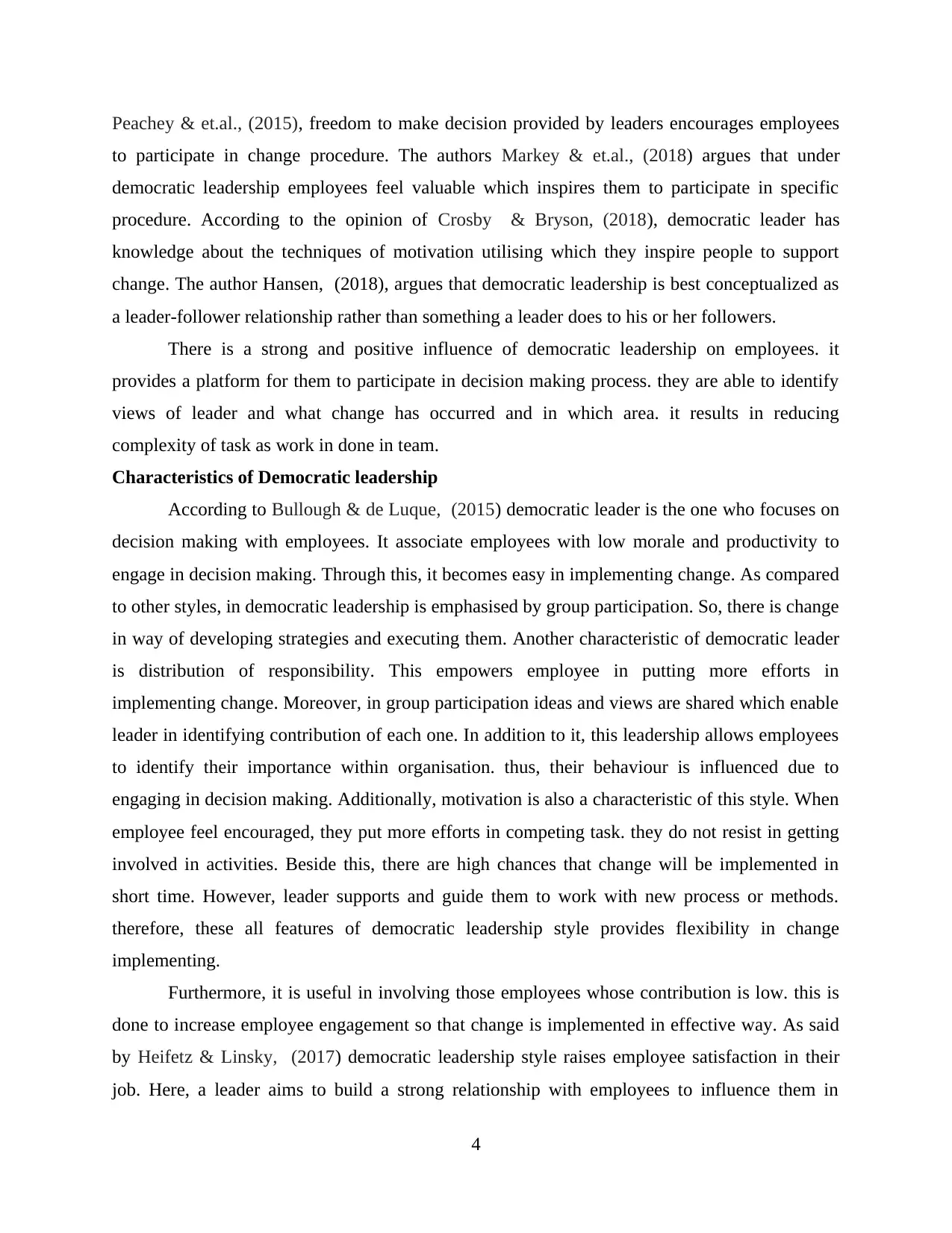
Peachey & et.al., (2015), freedom to make decision provided by leaders encourages employees
to participate in change procedure. The authors Markey & et.al., (2018) argues that under
democratic leadership employees feel valuable which inspires them to participate in specific
procedure. According to the opinion of Crosby & Bryson, (2018), democratic leader has
knowledge about the techniques of motivation utilising which they inspire people to support
change. The author Hansen, (2018), argues that democratic leadership is best conceptualized as
a leader-follower relationship rather than something a leader does to his or her followers.
There is a strong and positive influence of democratic leadership on employees. it
provides a platform for them to participate in decision making process. they are able to identify
views of leader and what change has occurred and in which area. it results in reducing
complexity of task as work in done in team.
Characteristics of Democratic leadership
According to Bullough & de Luque, (2015) democratic leader is the one who focuses on
decision making with employees. It associate employees with low morale and productivity to
engage in decision making. Through this, it becomes easy in implementing change. As compared
to other styles, in democratic leadership is emphasised by group participation. So, there is change
in way of developing strategies and executing them. Another characteristic of democratic leader
is distribution of responsibility. This empowers employee in putting more efforts in
implementing change. Moreover, in group participation ideas and views are shared which enable
leader in identifying contribution of each one. In addition to it, this leadership allows employees
to identify their importance within organisation. thus, their behaviour is influenced due to
engaging in decision making. Additionally, motivation is also a characteristic of this style. When
employee feel encouraged, they put more efforts in competing task. they do not resist in getting
involved in activities. Beside this, there are high chances that change will be implemented in
short time. However, leader supports and guide them to work with new process or methods.
therefore, these all features of democratic leadership style provides flexibility in change
implementing.
Furthermore, it is useful in involving those employees whose contribution is low. this is
done to increase employee engagement so that change is implemented in effective way. As said
by Heifetz & Linsky, (2017) democratic leadership style raises employee satisfaction in their
job. Here, a leader aims to build a strong relationship with employees to influence them in
4
to participate in change procedure. The authors Markey & et.al., (2018) argues that under
democratic leadership employees feel valuable which inspires them to participate in specific
procedure. According to the opinion of Crosby & Bryson, (2018), democratic leader has
knowledge about the techniques of motivation utilising which they inspire people to support
change. The author Hansen, (2018), argues that democratic leadership is best conceptualized as
a leader-follower relationship rather than something a leader does to his or her followers.
There is a strong and positive influence of democratic leadership on employees. it
provides a platform for them to participate in decision making process. they are able to identify
views of leader and what change has occurred and in which area. it results in reducing
complexity of task as work in done in team.
Characteristics of Democratic leadership
According to Bullough & de Luque, (2015) democratic leader is the one who focuses on
decision making with employees. It associate employees with low morale and productivity to
engage in decision making. Through this, it becomes easy in implementing change. As compared
to other styles, in democratic leadership is emphasised by group participation. So, there is change
in way of developing strategies and executing them. Another characteristic of democratic leader
is distribution of responsibility. This empowers employee in putting more efforts in
implementing change. Moreover, in group participation ideas and views are shared which enable
leader in identifying contribution of each one. In addition to it, this leadership allows employees
to identify their importance within organisation. thus, their behaviour is influenced due to
engaging in decision making. Additionally, motivation is also a characteristic of this style. When
employee feel encouraged, they put more efforts in competing task. they do not resist in getting
involved in activities. Beside this, there are high chances that change will be implemented in
short time. However, leader supports and guide them to work with new process or methods.
therefore, these all features of democratic leadership style provides flexibility in change
implementing.
Furthermore, it is useful in involving those employees whose contribution is low. this is
done to increase employee engagement so that change is implemented in effective way. As said
by Heifetz & Linsky, (2017) democratic leadership style raises employee satisfaction in their
job. Here, a leader aims to build a strong relationship with employees to influence them in
4
⊘ This is a preview!⊘
Do you want full access?
Subscribe today to unlock all pages.

Trusted by 1+ million students worldwide
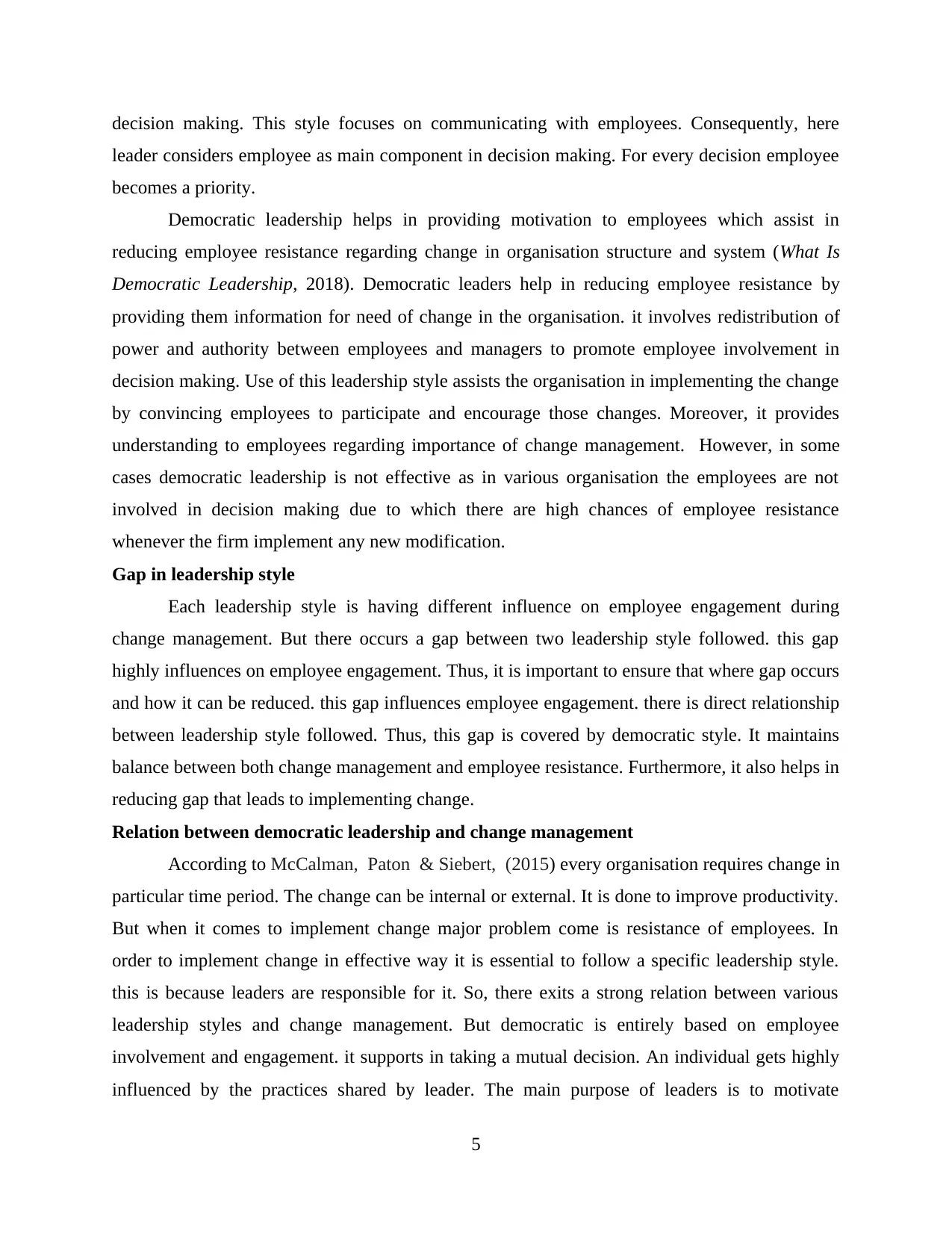
decision making. This style focuses on communicating with employees. Consequently, here
leader considers employee as main component in decision making. For every decision employee
becomes a priority.
Democratic leadership helps in providing motivation to employees which assist in
reducing employee resistance regarding change in organisation structure and system (What Is
Democratic Leadership, 2018). Democratic leaders help in reducing employee resistance by
providing them information for need of change in the organisation. it involves redistribution of
power and authority between employees and managers to promote employee involvement in
decision making. Use of this leadership style assists the organisation in implementing the change
by convincing employees to participate and encourage those changes. Moreover, it provides
understanding to employees regarding importance of change management. However, in some
cases democratic leadership is not effective as in various organisation the employees are not
involved in decision making due to which there are high chances of employee resistance
whenever the firm implement any new modification.
Gap in leadership style
Each leadership style is having different influence on employee engagement during
change management. But there occurs a gap between two leadership style followed. this gap
highly influences on employee engagement. Thus, it is important to ensure that where gap occurs
and how it can be reduced. this gap influences employee engagement. there is direct relationship
between leadership style followed. Thus, this gap is covered by democratic style. It maintains
balance between both change management and employee resistance. Furthermore, it also helps in
reducing gap that leads to implementing change.
Relation between democratic leadership and change management
According to McCalman, Paton & Siebert, (2015) every organisation requires change in
particular time period. The change can be internal or external. It is done to improve productivity.
But when it comes to implement change major problem come is resistance of employees. In
order to implement change in effective way it is essential to follow a specific leadership style.
this is because leaders are responsible for it. So, there exits a strong relation between various
leadership styles and change management. But democratic is entirely based on employee
involvement and engagement. it supports in taking a mutual decision. An individual gets highly
influenced by the practices shared by leader. The main purpose of leaders is to motivate
5
leader considers employee as main component in decision making. For every decision employee
becomes a priority.
Democratic leadership helps in providing motivation to employees which assist in
reducing employee resistance regarding change in organisation structure and system (What Is
Democratic Leadership, 2018). Democratic leaders help in reducing employee resistance by
providing them information for need of change in the organisation. it involves redistribution of
power and authority between employees and managers to promote employee involvement in
decision making. Use of this leadership style assists the organisation in implementing the change
by convincing employees to participate and encourage those changes. Moreover, it provides
understanding to employees regarding importance of change management. However, in some
cases democratic leadership is not effective as in various organisation the employees are not
involved in decision making due to which there are high chances of employee resistance
whenever the firm implement any new modification.
Gap in leadership style
Each leadership style is having different influence on employee engagement during
change management. But there occurs a gap between two leadership style followed. this gap
highly influences on employee engagement. Thus, it is important to ensure that where gap occurs
and how it can be reduced. this gap influences employee engagement. there is direct relationship
between leadership style followed. Thus, this gap is covered by democratic style. It maintains
balance between both change management and employee resistance. Furthermore, it also helps in
reducing gap that leads to implementing change.
Relation between democratic leadership and change management
According to McCalman, Paton & Siebert, (2015) every organisation requires change in
particular time period. The change can be internal or external. It is done to improve productivity.
But when it comes to implement change major problem come is resistance of employees. In
order to implement change in effective way it is essential to follow a specific leadership style.
this is because leaders are responsible for it. So, there exits a strong relation between various
leadership styles and change management. But democratic is entirely based on employee
involvement and engagement. it supports in taking a mutual decision. An individual gets highly
influenced by the practices shared by leader. The main purpose of leaders is to motivate
5
Paraphrase This Document
Need a fresh take? Get an instant paraphrase of this document with our AI Paraphraser
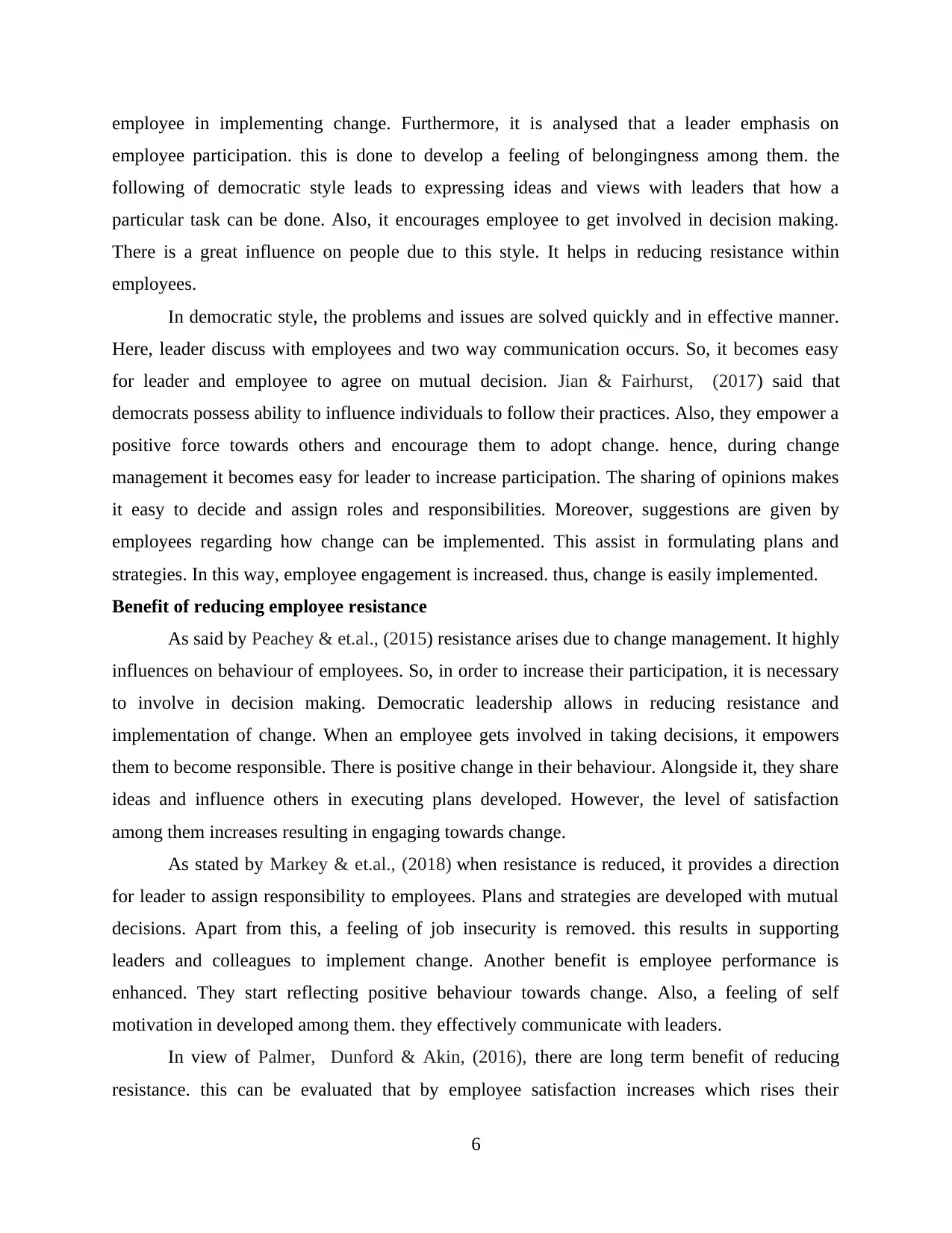
employee in implementing change. Furthermore, it is analysed that a leader emphasis on
employee participation. this is done to develop a feeling of belongingness among them. the
following of democratic style leads to expressing ideas and views with leaders that how a
particular task can be done. Also, it encourages employee to get involved in decision making.
There is a great influence on people due to this style. It helps in reducing resistance within
employees.
In democratic style, the problems and issues are solved quickly and in effective manner.
Here, leader discuss with employees and two way communication occurs. So, it becomes easy
for leader and employee to agree on mutual decision. Jian & Fairhurst, (2017) said that
democrats possess ability to influence individuals to follow their practices. Also, they empower a
positive force towards others and encourage them to adopt change. hence, during change
management it becomes easy for leader to increase participation. The sharing of opinions makes
it easy to decide and assign roles and responsibilities. Moreover, suggestions are given by
employees regarding how change can be implemented. This assist in formulating plans and
strategies. In this way, employee engagement is increased. thus, change is easily implemented.
Benefit of reducing employee resistance
As said by Peachey & et.al., (2015) resistance arises due to change management. It highly
influences on behaviour of employees. So, in order to increase their participation, it is necessary
to involve in decision making. Democratic leadership allows in reducing resistance and
implementation of change. When an employee gets involved in taking decisions, it empowers
them to become responsible. There is positive change in their behaviour. Alongside it, they share
ideas and influence others in executing plans developed. However, the level of satisfaction
among them increases resulting in engaging towards change.
As stated by Markey & et.al., (2018) when resistance is reduced, it provides a direction
for leader to assign responsibility to employees. Plans and strategies are developed with mutual
decisions. Apart from this, a feeling of job insecurity is removed. this results in supporting
leaders and colleagues to implement change. Another benefit is employee performance is
enhanced. They start reflecting positive behaviour towards change. Also, a feeling of self
motivation in developed among them. they effectively communicate with leaders.
In view of Palmer, Dunford & Akin, (2016), there are long term benefit of reducing
resistance. this can be evaluated that by employee satisfaction increases which rises their
6
employee participation. this is done to develop a feeling of belongingness among them. the
following of democratic style leads to expressing ideas and views with leaders that how a
particular task can be done. Also, it encourages employee to get involved in decision making.
There is a great influence on people due to this style. It helps in reducing resistance within
employees.
In democratic style, the problems and issues are solved quickly and in effective manner.
Here, leader discuss with employees and two way communication occurs. So, it becomes easy
for leader and employee to agree on mutual decision. Jian & Fairhurst, (2017) said that
democrats possess ability to influence individuals to follow their practices. Also, they empower a
positive force towards others and encourage them to adopt change. hence, during change
management it becomes easy for leader to increase participation. The sharing of opinions makes
it easy to decide and assign roles and responsibilities. Moreover, suggestions are given by
employees regarding how change can be implemented. This assist in formulating plans and
strategies. In this way, employee engagement is increased. thus, change is easily implemented.
Benefit of reducing employee resistance
As said by Peachey & et.al., (2015) resistance arises due to change management. It highly
influences on behaviour of employees. So, in order to increase their participation, it is necessary
to involve in decision making. Democratic leadership allows in reducing resistance and
implementation of change. When an employee gets involved in taking decisions, it empowers
them to become responsible. There is positive change in their behaviour. Alongside it, they share
ideas and influence others in executing plans developed. However, the level of satisfaction
among them increases resulting in engaging towards change.
As stated by Markey & et.al., (2018) when resistance is reduced, it provides a direction
for leader to assign responsibility to employees. Plans and strategies are developed with mutual
decisions. Apart from this, a feeling of job insecurity is removed. this results in supporting
leaders and colleagues to implement change. Another benefit is employee performance is
enhanced. They start reflecting positive behaviour towards change. Also, a feeling of self
motivation in developed among them. they effectively communicate with leaders.
In view of Palmer, Dunford & Akin, (2016), there are long term benefit of reducing
resistance. this can be evaluated that by employee satisfaction increases which rises their
6
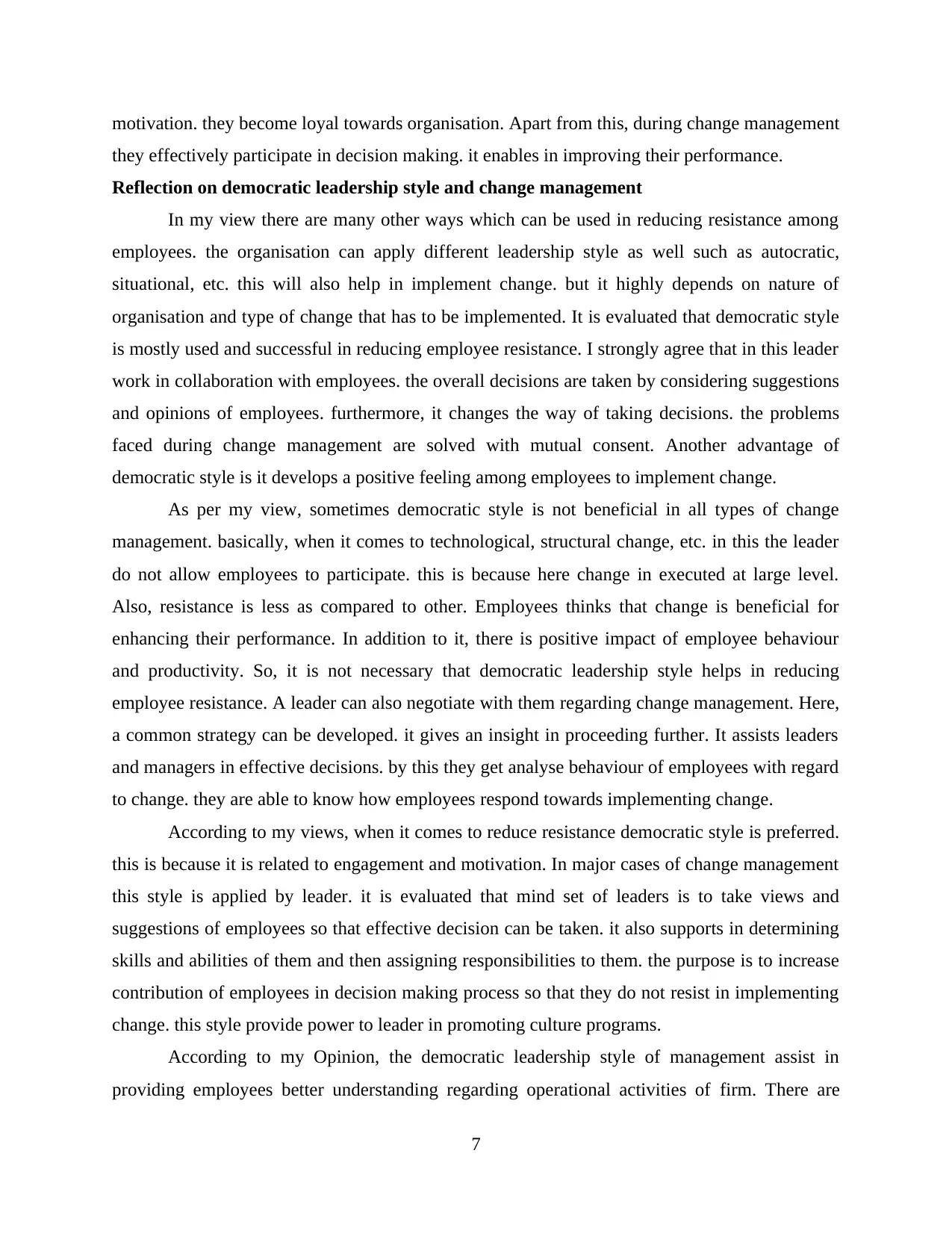
motivation. they become loyal towards organisation. Apart from this, during change management
they effectively participate in decision making. it enables in improving their performance.
Reflection on democratic leadership style and change management
In my view there are many other ways which can be used in reducing resistance among
employees. the organisation can apply different leadership style as well such as autocratic,
situational, etc. this will also help in implement change. but it highly depends on nature of
organisation and type of change that has to be implemented. It is evaluated that democratic style
is mostly used and successful in reducing employee resistance. I strongly agree that in this leader
work in collaboration with employees. the overall decisions are taken by considering suggestions
and opinions of employees. furthermore, it changes the way of taking decisions. the problems
faced during change management are solved with mutual consent. Another advantage of
democratic style is it develops a positive feeling among employees to implement change.
As per my view, sometimes democratic style is not beneficial in all types of change
management. basically, when it comes to technological, structural change, etc. in this the leader
do not allow employees to participate. this is because here change in executed at large level.
Also, resistance is less as compared to other. Employees thinks that change is beneficial for
enhancing their performance. In addition to it, there is positive impact of employee behaviour
and productivity. So, it is not necessary that democratic leadership style helps in reducing
employee resistance. A leader can also negotiate with them regarding change management. Here,
a common strategy can be developed. it gives an insight in proceeding further. It assists leaders
and managers in effective decisions. by this they get analyse behaviour of employees with regard
to change. they are able to know how employees respond towards implementing change.
According to my views, when it comes to reduce resistance democratic style is preferred.
this is because it is related to engagement and motivation. In major cases of change management
this style is applied by leader. it is evaluated that mind set of leaders is to take views and
suggestions of employees so that effective decision can be taken. it also supports in determining
skills and abilities of them and then assigning responsibilities to them. the purpose is to increase
contribution of employees in decision making process so that they do not resist in implementing
change. this style provide power to leader in promoting culture programs.
According to my Opinion, the democratic leadership style of management assist in
providing employees better understanding regarding operational activities of firm. There are
7
they effectively participate in decision making. it enables in improving their performance.
Reflection on democratic leadership style and change management
In my view there are many other ways which can be used in reducing resistance among
employees. the organisation can apply different leadership style as well such as autocratic,
situational, etc. this will also help in implement change. but it highly depends on nature of
organisation and type of change that has to be implemented. It is evaluated that democratic style
is mostly used and successful in reducing employee resistance. I strongly agree that in this leader
work in collaboration with employees. the overall decisions are taken by considering suggestions
and opinions of employees. furthermore, it changes the way of taking decisions. the problems
faced during change management are solved with mutual consent. Another advantage of
democratic style is it develops a positive feeling among employees to implement change.
As per my view, sometimes democratic style is not beneficial in all types of change
management. basically, when it comes to technological, structural change, etc. in this the leader
do not allow employees to participate. this is because here change in executed at large level.
Also, resistance is less as compared to other. Employees thinks that change is beneficial for
enhancing their performance. In addition to it, there is positive impact of employee behaviour
and productivity. So, it is not necessary that democratic leadership style helps in reducing
employee resistance. A leader can also negotiate with them regarding change management. Here,
a common strategy can be developed. it gives an insight in proceeding further. It assists leaders
and managers in effective decisions. by this they get analyse behaviour of employees with regard
to change. they are able to know how employees respond towards implementing change.
According to my views, when it comes to reduce resistance democratic style is preferred.
this is because it is related to engagement and motivation. In major cases of change management
this style is applied by leader. it is evaluated that mind set of leaders is to take views and
suggestions of employees so that effective decision can be taken. it also supports in determining
skills and abilities of them and then assigning responsibilities to them. the purpose is to increase
contribution of employees in decision making process so that they do not resist in implementing
change. this style provide power to leader in promoting culture programs.
According to my Opinion, the democratic leadership style of management assist in
providing employees better understanding regarding operational activities of firm. There are
7
⊘ This is a preview!⊘
Do you want full access?
Subscribe today to unlock all pages.

Trusted by 1+ million students worldwide
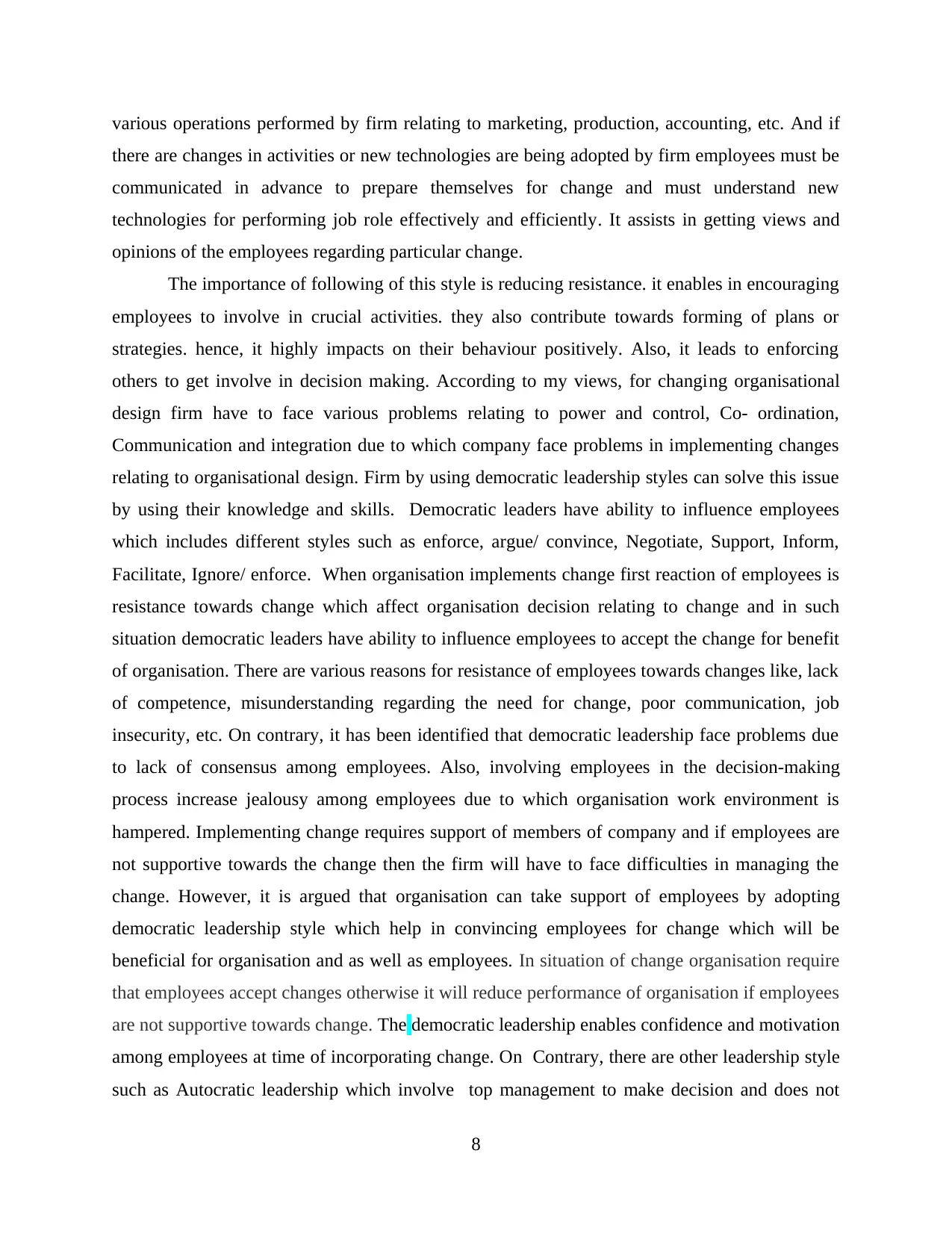
various operations performed by firm relating to marketing, production, accounting, etc. And if
there are changes in activities or new technologies are being adopted by firm employees must be
communicated in advance to prepare themselves for change and must understand new
technologies for performing job role effectively and efficiently. It assists in getting views and
opinions of the employees regarding particular change.
The importance of following of this style is reducing resistance. it enables in encouraging
employees to involve in crucial activities. they also contribute towards forming of plans or
strategies. hence, it highly impacts on their behaviour positively. Also, it leads to enforcing
others to get involve in decision making. According to my views, for changing organisational
design firm have to face various problems relating to power and control, Co- ordination,
Communication and integration due to which company face problems in implementing changes
relating to organisational design. Firm by using democratic leadership styles can solve this issue
by using their knowledge and skills. Democratic leaders have ability to influence employees
which includes different styles such as enforce, argue/ convince, Negotiate, Support, Inform,
Facilitate, Ignore/ enforce. When organisation implements change first reaction of employees is
resistance towards change which affect organisation decision relating to change and in such
situation democratic leaders have ability to influence employees to accept the change for benefit
of organisation. There are various reasons for resistance of employees towards changes like, lack
of competence, misunderstanding regarding the need for change, poor communication, job
insecurity, etc. On contrary, it has been identified that democratic leadership face problems due
to lack of consensus among employees. Also, involving employees in the decision-making
process increase jealousy among employees due to which organisation work environment is
hampered. Implementing change requires support of members of company and if employees are
not supportive towards the change then the firm will have to face difficulties in managing the
change. However, it is argued that organisation can take support of employees by adopting
democratic leadership style which help in convincing employees for change which will be
beneficial for organisation and as well as employees. In situation of change organisation require
that employees accept changes otherwise it will reduce performance of organisation if employees
are not supportive towards change. The democratic leadership enables confidence and motivation
among employees at time of incorporating change. On Contrary, there are other leadership style
such as Autocratic leadership which involve top management to make decision and does not
8
there are changes in activities or new technologies are being adopted by firm employees must be
communicated in advance to prepare themselves for change and must understand new
technologies for performing job role effectively and efficiently. It assists in getting views and
opinions of the employees regarding particular change.
The importance of following of this style is reducing resistance. it enables in encouraging
employees to involve in crucial activities. they also contribute towards forming of plans or
strategies. hence, it highly impacts on their behaviour positively. Also, it leads to enforcing
others to get involve in decision making. According to my views, for changing organisational
design firm have to face various problems relating to power and control, Co- ordination,
Communication and integration due to which company face problems in implementing changes
relating to organisational design. Firm by using democratic leadership styles can solve this issue
by using their knowledge and skills. Democratic leaders have ability to influence employees
which includes different styles such as enforce, argue/ convince, Negotiate, Support, Inform,
Facilitate, Ignore/ enforce. When organisation implements change first reaction of employees is
resistance towards change which affect organisation decision relating to change and in such
situation democratic leaders have ability to influence employees to accept the change for benefit
of organisation. There are various reasons for resistance of employees towards changes like, lack
of competence, misunderstanding regarding the need for change, poor communication, job
insecurity, etc. On contrary, it has been identified that democratic leadership face problems due
to lack of consensus among employees. Also, involving employees in the decision-making
process increase jealousy among employees due to which organisation work environment is
hampered. Implementing change requires support of members of company and if employees are
not supportive towards the change then the firm will have to face difficulties in managing the
change. However, it is argued that organisation can take support of employees by adopting
democratic leadership style which help in convincing employees for change which will be
beneficial for organisation and as well as employees. In situation of change organisation require
that employees accept changes otherwise it will reduce performance of organisation if employees
are not supportive towards change. The democratic leadership enables confidence and motivation
among employees at time of incorporating change. On Contrary, there are other leadership style
such as Autocratic leadership which involve top management to make decision and does not
8
Paraphrase This Document
Need a fresh take? Get an instant paraphrase of this document with our AI Paraphraser
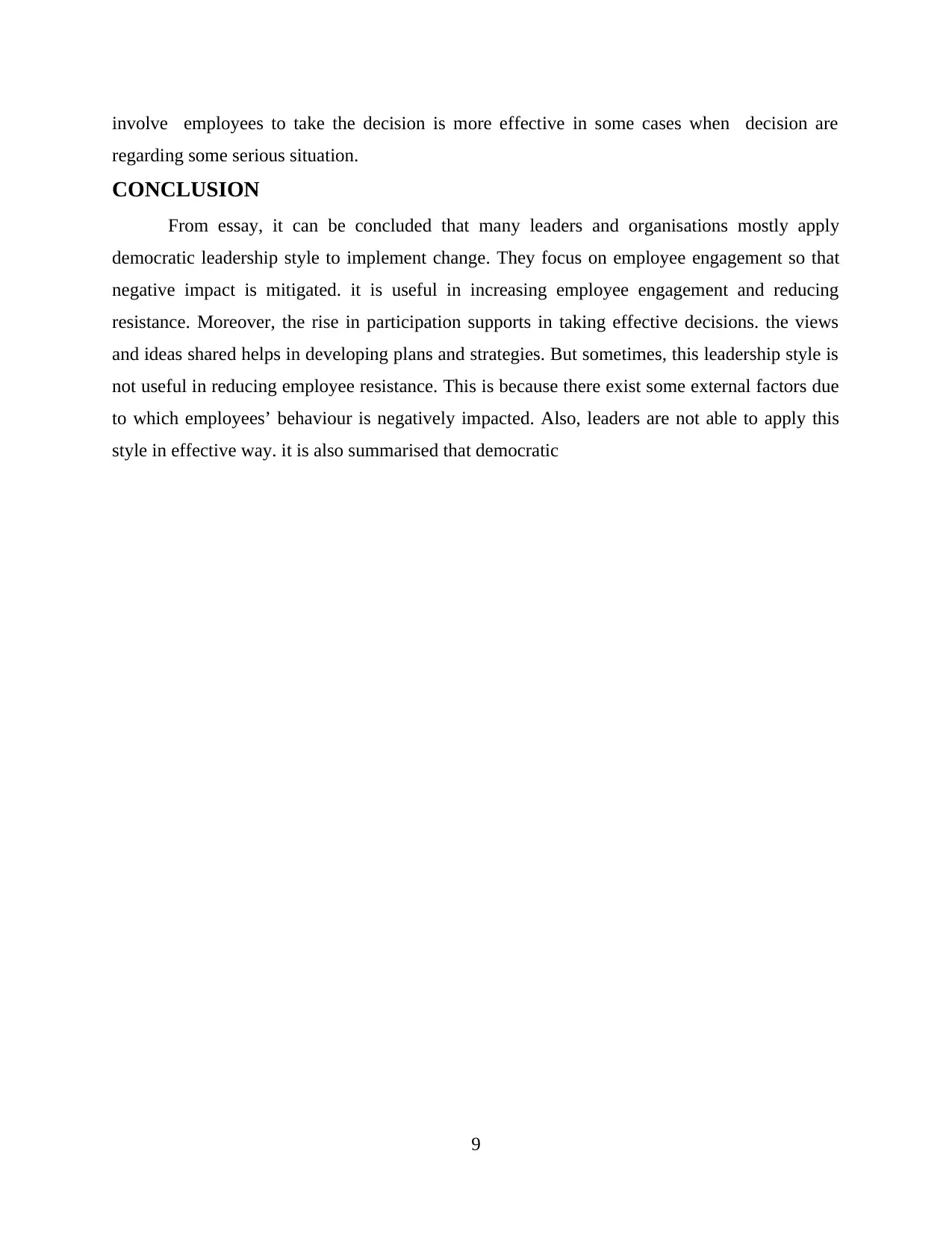
involve employees to take the decision is more effective in some cases when decision are
regarding some serious situation.
CONCLUSION
From essay, it can be concluded that many leaders and organisations mostly apply
democratic leadership style to implement change. They focus on employee engagement so that
negative impact is mitigated. it is useful in increasing employee engagement and reducing
resistance. Moreover, the rise in participation supports in taking effective decisions. the views
and ideas shared helps in developing plans and strategies. But sometimes, this leadership style is
not useful in reducing employee resistance. This is because there exist some external factors due
to which employees’ behaviour is negatively impacted. Also, leaders are not able to apply this
style in effective way. it is also summarised that democratic
9
regarding some serious situation.
CONCLUSION
From essay, it can be concluded that many leaders and organisations mostly apply
democratic leadership style to implement change. They focus on employee engagement so that
negative impact is mitigated. it is useful in increasing employee engagement and reducing
resistance. Moreover, the rise in participation supports in taking effective decisions. the views
and ideas shared helps in developing plans and strategies. But sometimes, this leadership style is
not useful in reducing employee resistance. This is because there exist some external factors due
to which employees’ behaviour is negatively impacted. Also, leaders are not able to apply this
style in effective way. it is also summarised that democratic
9
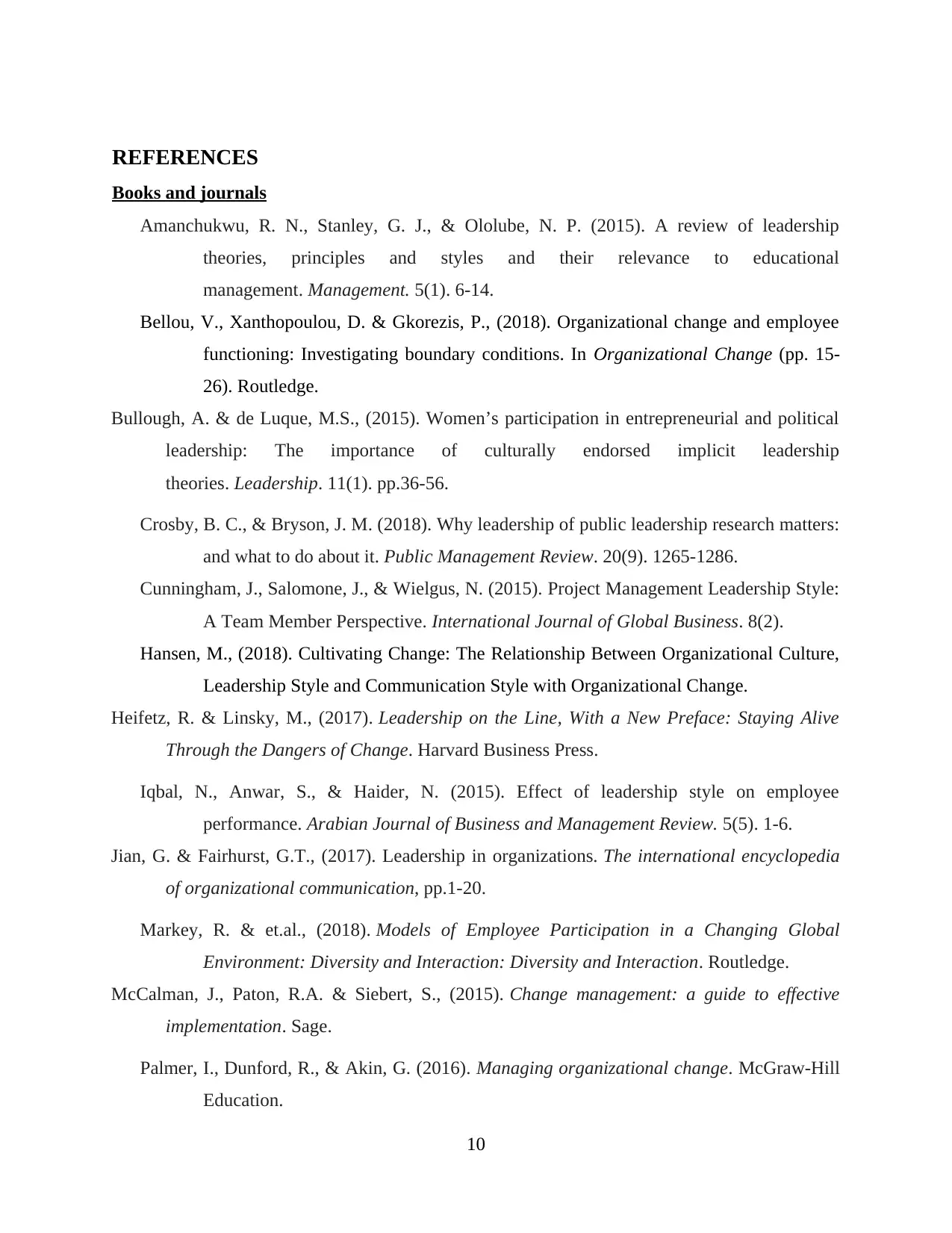
REFERENCES
Books and journals
Amanchukwu, R. N., Stanley, G. J., & Ololube, N. P. (2015). A review of leadership
theories, principles and styles and their relevance to educational
management. Management. 5(1). 6-14.
Bellou, V., Xanthopoulou, D. & Gkorezis, P., (2018). Organizational change and employee
functioning: Investigating boundary conditions. In Organizational Change (pp. 15-
26). Routledge.
Bullough, A. & de Luque, M.S., (2015). Women’s participation in entrepreneurial and political
leadership: The importance of culturally endorsed implicit leadership
theories. Leadership. 11(1). pp.36-56.
Crosby, B. C., & Bryson, J. M. (2018). Why leadership of public leadership research matters:
and what to do about it. Public Management Review. 20(9). 1265-1286.
Cunningham, J., Salomone, J., & Wielgus, N. (2015). Project Management Leadership Style:
A Team Member Perspective. International Journal of Global Business. 8(2).
Hansen, M., (2018). Cultivating Change: The Relationship Between Organizational Culture,
Leadership Style and Communication Style with Organizational Change.
Heifetz, R. & Linsky, M., (2017). Leadership on the Line, With a New Preface: Staying Alive
Through the Dangers of Change. Harvard Business Press.
Iqbal, N., Anwar, S., & Haider, N. (2015). Effect of leadership style on employee
performance. Arabian Journal of Business and Management Review. 5(5). 1-6.
Jian, G. & Fairhurst, G.T., (2017). Leadership in organizations. The international encyclopedia
of organizational communication, pp.1-20.
Markey, R. & et.al., (2018). Models of Employee Participation in a Changing Global
Environment: Diversity and Interaction: Diversity and Interaction. Routledge.
McCalman, J., Paton, R.A. & Siebert, S., (2015). Change management: a guide to effective
implementation. Sage.
Palmer, I., Dunford, R., & Akin, G. (2016). Managing organizational change. McGraw-Hill
Education.
10
Books and journals
Amanchukwu, R. N., Stanley, G. J., & Ololube, N. P. (2015). A review of leadership
theories, principles and styles and their relevance to educational
management. Management. 5(1). 6-14.
Bellou, V., Xanthopoulou, D. & Gkorezis, P., (2018). Organizational change and employee
functioning: Investigating boundary conditions. In Organizational Change (pp. 15-
26). Routledge.
Bullough, A. & de Luque, M.S., (2015). Women’s participation in entrepreneurial and political
leadership: The importance of culturally endorsed implicit leadership
theories. Leadership. 11(1). pp.36-56.
Crosby, B. C., & Bryson, J. M. (2018). Why leadership of public leadership research matters:
and what to do about it. Public Management Review. 20(9). 1265-1286.
Cunningham, J., Salomone, J., & Wielgus, N. (2015). Project Management Leadership Style:
A Team Member Perspective. International Journal of Global Business. 8(2).
Hansen, M., (2018). Cultivating Change: The Relationship Between Organizational Culture,
Leadership Style and Communication Style with Organizational Change.
Heifetz, R. & Linsky, M., (2017). Leadership on the Line, With a New Preface: Staying Alive
Through the Dangers of Change. Harvard Business Press.
Iqbal, N., Anwar, S., & Haider, N. (2015). Effect of leadership style on employee
performance. Arabian Journal of Business and Management Review. 5(5). 1-6.
Jian, G. & Fairhurst, G.T., (2017). Leadership in organizations. The international encyclopedia
of organizational communication, pp.1-20.
Markey, R. & et.al., (2018). Models of Employee Participation in a Changing Global
Environment: Diversity and Interaction: Diversity and Interaction. Routledge.
McCalman, J., Paton, R.A. & Siebert, S., (2015). Change management: a guide to effective
implementation. Sage.
Palmer, I., Dunford, R., & Akin, G. (2016). Managing organizational change. McGraw-Hill
Education.
10
⊘ This is a preview!⊘
Do you want full access?
Subscribe today to unlock all pages.

Trusted by 1+ million students worldwide
1 out of 15
Related Documents
Your All-in-One AI-Powered Toolkit for Academic Success.
+13062052269
info@desklib.com
Available 24*7 on WhatsApp / Email
![[object Object]](/_next/static/media/star-bottom.7253800d.svg)
Unlock your academic potential
Copyright © 2020–2025 A2Z Services. All Rights Reserved. Developed and managed by ZUCOL.





